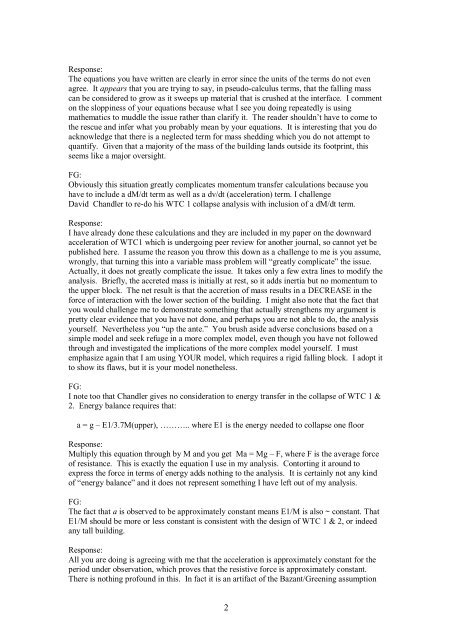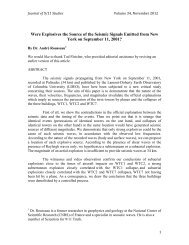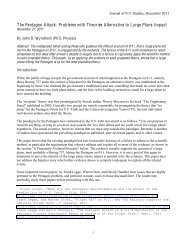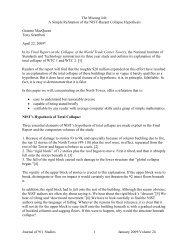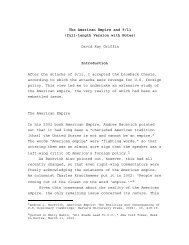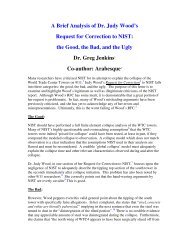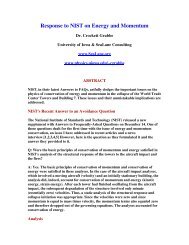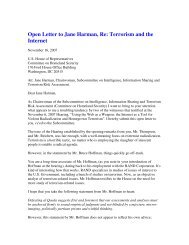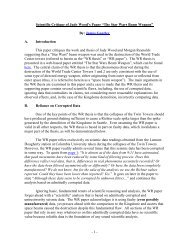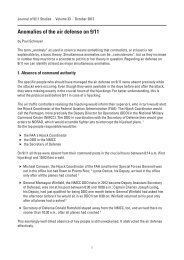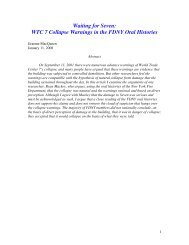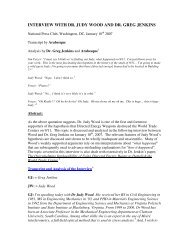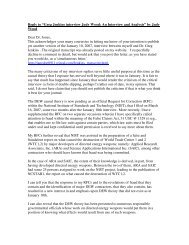David Chandler Responds to Frank Greening - Journal of 9/11 Studies
David Chandler Responds to Frank Greening - Journal of 9/11 Studies
David Chandler Responds to Frank Greening - Journal of 9/11 Studies
Create successful ePaper yourself
Turn your PDF publications into a flip-book with our unique Google optimized e-Paper software.
Response:<br />
The equations you have written are clearly in error since the units <strong>of</strong> the terms do not even<br />
agree. It appears that you are trying <strong>to</strong> say, in pseudo-calculus terms, that the falling mass<br />
can be considered <strong>to</strong> grow as it sweeps up material that is crushed at the interface. I comment<br />
on the sloppiness <strong>of</strong> your equations because what I see you doing repeatedly is using<br />
mathematics <strong>to</strong> muddle the issue rather than clarify it. The reader shouldn’t have <strong>to</strong> come <strong>to</strong><br />
the rescue and infer what you probably mean by your equations. It is interesting that you do<br />
acknowledge that there is a neglected term for mass shedding which you do not attempt <strong>to</strong><br />
quantify. Given that a majority <strong>of</strong> the mass <strong>of</strong> the building lands outside its footprint, this<br />
seems like a major oversight.<br />
FG:<br />
Obviously this situation greatly complicates momentum transfer calculations because you<br />
have <strong>to</strong> include a dM/dt term as well as a dv/dt (acceleration) term. I challenge<br />
<strong>David</strong> <strong>Chandler</strong> <strong>to</strong> re-do his WTC 1 collapse analysis with inclusion <strong>of</strong> a dM/dt term.<br />
Response:<br />
I have already done these calculations and they are included in my paper on the downward<br />
acceleration <strong>of</strong> WTC1 which is undergoing peer review for another journal, so cannot yet be<br />
published here. I assume the reason you throw this down as a challenge <strong>to</strong> me is you assume,<br />
wrongly, that turning this in<strong>to</strong> a variable mass problem will “greatly complicate” the issue.<br />
Actually, it does not greatly complicate the issue. It takes only a few extra lines <strong>to</strong> modify the<br />
analysis. Briefly, the accreted mass is initially at rest, so it adds inertia but no momentum <strong>to</strong><br />
the upper block. The net result is that the accretion <strong>of</strong> mass results in a DECREASE in the<br />
force <strong>of</strong> interaction with the lower section <strong>of</strong> the building. I might also note that the fact that<br />
you would challenge me <strong>to</strong> demonstrate something that actually strengthens my argument is<br />
pretty clear evidence that you have not done, and perhaps you are not able <strong>to</strong> do, the analysis<br />
yourself. Nevertheless you “up the ante.” You brush aside adverse conclusions based on a<br />
simple model and seek refuge in a more complex model, even though you have not followed<br />
through and investigated the implications <strong>of</strong> the more complex model yourself. I must<br />
emphasize again that I am using YOUR model, which requires a rigid falling block. I adopt it<br />
<strong>to</strong> show its flaws, but it is your model nonetheless.<br />
FG:<br />
I note <strong>to</strong>o that <strong>Chandler</strong> gives no consideration <strong>to</strong> energy transfer in the collapse <strong>of</strong> WTC 1 &<br />
2. Energy balance requires that:<br />
a = g – E1/3.7M(upper), ……….. where E1 is the energy needed <strong>to</strong> collapse one floor<br />
Response:<br />
Multiply this equation through by M and you get Ma = Mg – F, where F is the average force<br />
<strong>of</strong> resistance. This is exactly the equation I use in my analysis. Con<strong>to</strong>rting it around <strong>to</strong><br />
express the force in terms <strong>of</strong> energy adds nothing <strong>to</strong> the analysis. It is certainly not any kind<br />
<strong>of</strong> “energy balance” and it does not represent something I have left out <strong>of</strong> my analysis.<br />
FG:<br />
The fact that a is observed <strong>to</strong> be approximately constant means E1/M is also ~ constant. That<br />
E1/M should be more or less constant is consistent with the design <strong>of</strong> WTC 1 & 2, or indeed<br />
any tall building.<br />
Response:<br />
All you are doing is agreeing with me that the acceleration is approximately constant for the<br />
period under observation, which proves that the resistive force is approximately constant.<br />
There is nothing pr<strong>of</strong>ound in this. In fact it is an artifact <strong>of</strong> the Bazant/<strong>Greening</strong> assumption<br />
2


